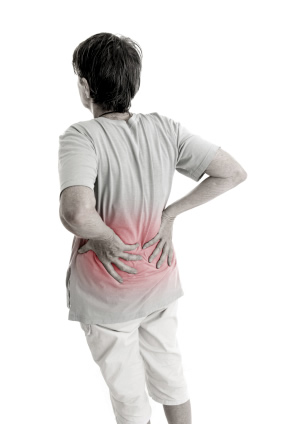Acute lower (or lumbar) back pain is very common; in fact 80% of adults will have back pain at some point in their life.
‘Acute’ simply means that the episode of back pain lasts for no longer than 6 weeks. Most back pain, no matter how painful, usually gets better on it’s own. Acute back pain can range from “not too bad” to “severe”. When it is severe the muscles in the back can spasm or the back can “lock” in one position. Although this can be very painful and frightening, it is usually nothing serious.
Acute back pain is normally mechanical or non-specific. ‘Mechanical’ means that the pain is coming from the muscles, joints, bones and soft tissues around the spine. For example, ‘mechanical’ back pain caused by facet joint degeneration or wear and tear.
‘Non-specific’ back pain means there is no obvious cause but that does not mean it is any less painful.
Acute back pain is rarely serious and should be managed by your GP and/or physiotherapist. The most important message is take regular painkillers and keep active. Research shows that resting or lying flat on the floor/in bed may make your back pain worse and take longer to recover.
‘Chronic’ back pain means the back pain has lasted longer than 3 months. Again, it is essential that you keep exercising and, as far as possible, keep working. Lying in bed will make it worse.
Is my back pain serious?
Very occasionally back pain can be related to serious underlying problem such as infection, cancer or fractures. Patients with these problems may have symptoms similar to ‘non-mechanical’ back pain but the pain is constant and unrelated to increased activity. ‘Red Flag Signs’ are used to help identify people who may have one of these causes for their back pain.
These RED Flag Signs include:
- Non-mechanical back pain
- Age when the back pain first presents: under 20 years of age or over 50 years
- Thoracic back pain
- Past medical history including: Cancer, Steroid use, HIV infection, IV drug abuse
- Pain that wakes at night
- Unexplained weight loss
- Cauda Equina Syndrome
This is a condition that we treat as an emergency. The main symptoms are numbness or loss of sensation around the bottom area (back passage, perineum, testes and penis) and loss of sensation whilst passing urine/opening bowels or incontinence. The back pain is often severe and may go down both legs. If this happens you should go to A&E without delay. Delay in treatment can lead to double incontinence, loss of sexual function and paralysis.


Do I Need to See a Spinal Surgeon?
If the back pain becomes persistent, unmanageable or you have any red flag signs then further assessment by a spinal specialist and investigation of the spine may be required.
Your GP can organise a referral to a Spinal Surgeon if it is needed. For private referrals, you can be seen without an GP referral if you are self-funding and some insurance companies do not need a GP referral, however you should check first with your insurance company. Within the NHS, if you do not have red flags then your GP will usually refer to a spinal physiotherapist first. If needed you may then be referred to a spinal consultant.
Mr Hilton always takes a careful history and examination before deciding if further investigations are required. Standing X-rays and MRI scans are usually used to investigate the spine however there are other imaging techniques including CT scans and CT SPECT are also used.
X-rays
X-rays of the spine should be taken with the patient standing and initially two views are taken; AP (front view) and Lateral (side view). X-rays are good at looking the bones in the spine, their alignment, fractures (although they cannot distinguish between old and new fractures) and shape (curves) of the spine. X-rays are an important addition to MRI scans because MRI scans are taken with a patient lying down whereas the X-rays are taking with the patient weight-bearing.
MRI Scans
Magnetic Resonance Imaging Scans (MRI scans) are extremely sensitive and give a very clear picture of the soft tissues and bones in the spine and its surrounding structures (eg. discs, nerves, spinal cord and ligaments). It does not tell the doctor why the spine is painful but instead the information from the scan is used in conjunction with the information gained from the history and examination.
The MRI scan may show changes that are due to natural ageing. These changes are sometimes called “degenerative changes” or “wear and tear” of the spine/back; almost everyone has these changes on their MRI scan by middle age. These changes are normal and do not mean there is a problem and may not be the cause of the pain. It is important to remember “We treat patients not an MRI scan.” Treating a scan alone can lead to incorrect treatment. In the majority of cases of back pain alone, no obvious cause will be found. However, MRI scans are also extremely good at identifying and excluding serious spinal disorders like cancer and infection.
CT scans and CT-SPECT scans
CT images of the spine are used to look at bones, their shape, position and anatomy. The detailed 3-D images are produced by taking multiple X-ray images from different angles which are then processed by a computer. CT scans are also used for patients who cannot MRI scans, for example those patients who do not have MRI-compatible heart pace-makers.
CT SPECT scans are a combination of CT scans and a SPECT scan (or bone scan). A SPECT scan uses a radio-labelled dye to produce an image. We can use these combined images to see if there are any “hot spots” (lots of inflammation) in your spine or joints which may help when a diagnosis is difficult or when further information is required.
However, it is important to remember these are NOT “pain maps” and as with all imaging, any results need to be used in combination with the history and examination of a patient.
What treatment do I need?
Treatment options then depend upon the severity and duration of the symptoms as well as the underlying cause. Changes seen include facet joint arthritis, degenerative disc disease and spondylolisthesis. Treatment usually falls into the following three main categories.
Physical or ‘manual therapy’ and exercises
Manual therapy is usually performed by physiotherapists, chiropractors or osteopaths. In addition to manual therapy, the practitioner should show patients how to do appropriate exercises to improve their mobility and strengthen the muscles that support and protect the spine. Following this, the vast majority of patients will improve with these treatments. See Physiotherapy.
Injection therapy
The source of the pain may be the degenerate discs or the facet joints. Under these circumstances the pain may be improved by facet joint injections, medial branch blocks or pars injections.
Surgery
Most patients with back pain do not require surgery, especially if there is no leg pain/sciatica. Some patients will experience persistent spinal pain despite these treatments. Depending on the cause of the back pain and how debilitating it is, spinal surgery may be indicated. Surgery should only be undertaken following a period of conservative treatment and following discussion with the treating Spinal Surgeon who will be able to discuss the benefits and risks of the different treatment options which include spinal fusion and stabilisation.
Do I need to see a pain specialist?
Some patients will have persistent back pain despite treatment with physiotherapy and injection treatment. Unfortunately these patients may not gain benefit from injection treatment or surgery. Following assessment by the spinal specialist they may then refer you to a pain specialist. These are usually anaesthetists who specialise in pain management techniques.


